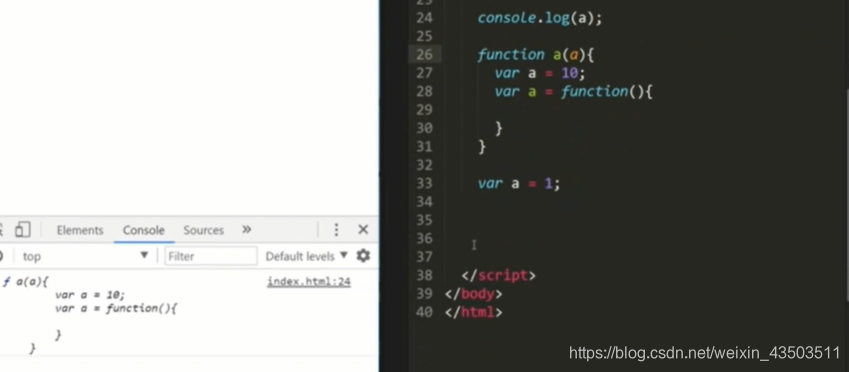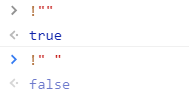1. 参数默认值
- 默认是undefined
- 形参可以有默认值,形参、实参哪个有值取哪个ES6,默认值属于ES6的内容,打印出的是符合人性化的结果
- 形参有默认值,形参、实参无法统一、无论实参传入有值还是undefined(代码表现)
function test(a = 1, b) {console.log(a, b)console.log(arguments[0]) // undefined
}
test(undefined, 1) // 1 1
function test(a = 1, b) {console.log(a, b)// 1 1console.log(arguments[0]) // undefineda = 8console.log(a) // 8console.log(arguments[0]) // undefined
}
test(undefined, 1)
function test(a, b) {console.log(a, b)// 2 1console.log(arguments[0]) // 2a = 8console.log(a) // 8console.log(arguments[0]) // 8
}
test(2, 1)
function test(a, b) {a = 3;console.log(a) // 3console.log(arguments[0]) // 3
}
test(1, 2)
function test(a = undefined, b) {console.log(a, b)
}
test(1, 1) // 1 1
// 用es5的写法设置默认值
function test(a, b) {a = arguments[0] || 1console.log(a, b) // 1 1
}
test(undefined, 1)
// typeof的方式
function test(a, b) {a = typeof (arguments[0]) === 'undefined'? 1: arguments[0]console.log(a, b)
}
test(undefined, 1) // 1 1
2. 预编译
- 检查通篇的语法错误
- 预编译的语法错误
- 解释一行,执行一行
- 函数声明,函数整体提升
- 变量声明,只有声明提升,赋值不提升

预编译的流程(函数执行前的步骤)
一、 函数内部
变量优先
- 创建AO对象:寻找函数里的形参和变量声明提升,添加到AO(活跃对象/函数上下文 activation object)里
- 把实参的值赋值给形参
- 寻找函数声明,添加到AO
- 执行函数(按函数语句走)// 执行时,对于前几步处理过的变量声明、函数声明将跳过
- 对于变量重复声明,红宝书的例子(js从来不会告诉你是否多次声明了同一个变量,遇到这种情况,它只会对后续的声明视而不见),不过它执行后续声明中的变量初始化
=注意-==
function countFn(count) {for (var i = 0; i < count; i++) {console.log(i) // 0 1 2 3 4}var i // 重复 视而不见console.log(i) // 5
}
countFn(5)
function test(a) { // 预编译第一步,将形参添加到AO时var avar aconsole.log(a) // 1
}
test(1)
// 打印
// f a(){}
// 1
// 1
// f (){}
function test(a) {console.log(a) // fn avar a = 1;console.log(a) // 1function a() { }console.log(a) // 1var b = function () { }console.log(b) // fn function d() { }
}
test(2)
function test(a, b) {console.log(a) // 1c = 0console.log(c) // 0var ca = 5console.log(a) // 5console.log(b) // f b(){}b = 6console.log(b) // 6function b() { }console.log(d) // f d(){}function d() { }console.log(b) // 6console.log(d) // f d(){}
}
test(1)
AO = {a:undefined → 1 → 5,b:undefined → f b → 6,c:undefined → 0,d: f d
}
二、全局
- 在通篇js执行前,创建GO(global object)全局上下文(即window)
- 寻找变量声明
- 寻找函数声明
- 执行(不要忘记赋值、注意执行顺序)
- 函数表达式显然是报错,GO里test是变量undefined

test()
var test = function () { }
function test2(){}
GO = {test:undefined → f test(){}test2: f test2(){}
}
// 打印
// f a(){}
// undefiendGO = {b:undefineda:fa
}


console.log(b) // undefined
var b = 3;
console.log(b) // 3
console.log(a) // f a(a)
function a(a) {console.log(a) // f a()a() // undefined 5var a = 2;console.log(a) // 2function a() {console.log(b)var b = 5;console.log(b)}
}
a(1)
GO = {b:undefineda:fa(a)
}
AO = {a:undefined → 1 → fa() → 2b:undefined →
}

- 不要混淆:AO内有a,不会再去查找GO里的a

- 预编译不管if语句的,只要有变量声明就要放入AO
- js中无块级作用域,即使用{}括起来,b也是声明在函数test内部的局部变量,会被添加到执行环境
- 使用var声明的变量会被自动添加到最接近的环境中

function test() {return a;a = 1;function a() {};var a = 2
}
console.log(test()) // f a(){}AO = {a:undefined → fa
}
function test() {a = 1;function a() { };var a = 2return a
}
console.log(test()) // 2
function test(e) {function e() { }console.log(e); // f e(){}arguments[0] = 2;console.log(e); // 2if (a) {var b = 3}var c;console.log(a); // undefineda = 4;var a;console.log(b); // undefinedf = 5;console.log(c); // undefinedconsole.log(a); // 4
}
var a
test(1)
console.log(f); // 5GO = {a: undefined test: f test(e){...},f: 5 // 在执行test内函数值
}
// 执行test(1)时创建AO
AO = {e:undefined → 1 → f e(){} → 2 b: undefined → c: undefined → a: undefined → 4
}暗示全局变量
- 未用var 声明的b就是暗示全局变量,是window的属性之一

function test() {var a = b = 1
// 1. var a
// 2. b = 1 (赋值,没有在function内部声明,是全局变量,存到window)
// 3. a = b (赋值)
}


练习
var a = false + 1;
console.log(a) // 1 隐式类型转换
var b = false == 1;
console.log(b) // false
注意运算符优先级&&低于+
运算符优先级
if (typeof (a) && (-true) + (+undefined) + '') {console.log('通过了') // 通过了} else {console.log('没通过')
}

if (1 + 5 * '3' === 16) {console.log('通过了') // 通过了
} else {console.log('没通过')
}

console.log(!!" " + !!'' - !!false || '没通过') // 1

)
)






)







时出现错误--修改sql mode)

